Abstract
The synthesized compound 1-(2-chlorophenyl) 6-7-dimethoxy-3-methyl-3,4-dihydroisoquinoline (DIQ) was investigated as a biological agent. Its potential to affect muscle contractility was predicted through in silico PASS analysis. Based on the in silico analysis, its capabilities were experimentally investigated. The study aimed to investigate the effects of DIQ on the ex vivo spontaneous contractile activity (CA) of smooth muscle (SM) tissue. DIQ was observed to reduce the strength of Ca2+-dependent contractions in SM preparations (SMP), possibly by increasing cytosolic Ca2+ levels through the activation of a voltage-gated L-type Ca2+ channel. DIQ potently affected calcium currents by modulating the function of muscarinic acetylcholine receptors (mAChRs) and 5-hydroxytryptamine (5-HT) receptors at a concentration of 50 μM. Immunohistochemical tests showed a 47% reduction in 5-HT2A and 5-HT2B receptor activity in SM cells and neurons in the myenteric plexus (MP), further confirming the effects of DIQ. Furthermore, a significant inhibition of neuronal activity was observed when the compound was co-administered with 5-HT to SM tissues. The conducted experiments confirm the ability of the isoquinoline analog to act as a physiologically active molecule to control muscle contractility and related physiological processes.
1. Introduction
The chemistry of natural and synthetic isoquinolines is a rapidly expanding area of study. The high prevalence of isoquinoline chemicals in nature and their significant function as biologically active molecules and compounds with useful medical applications all contribute to the ongoing attention [1,2].
Among the known dihydroisoquinolines, substances with cardiovascular activity, such as sympathomimetics, anticonvulsants, anticoagulants, analgesics, anti-inflammatory, and antiviral agents [3,4,5], and medicinal antispasmodics exist [6]. The presence of the isoquinoline ring is preferred as a structural unit for drug design and plays a pivotal role in the development of effective medicinal preparations for preclinical and clinical applications [7,8].
Previously, the molecule DIQ was synthesized with a very good yield (80%) and subsequently described [9]. The chlorine atom present in well-known drugs such as chloramphenicol, chloroquine, chlorambucil, etc., provides their respective antibacterial, anticancer, and antimalarial properties [10] (Figure 1).
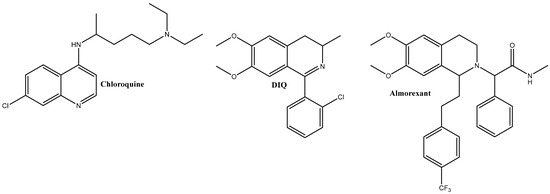
Figure 1.
Structures of chloroquine, almorexant, and DIQ.
Given the properties that the combined molecule would have from both a chlorine atom and a phenyl ring as functional groups attached to a modified 2-phenylethylamine, DIQ was chosen as a target compound.
The in silico simulations predicted muscle CA for the target molecule DIQ [9]. The results of this analysis can be confirmed experimentally by ex vivo tests on isolated SMPs from the rat stomach in tissue baths and subsequent in vitro histological analyses [10,11,12]. The advantage of this experimental model is that the described processes can modulate cytosolic Ca2+ concentration and, therefore, the SMPs’ reactivity to very low doses of the studied substances (up to nM) [13]. SM tissue contractility is regulated by hormones and nerve stimulation is controlled by the autonomic nervous system and local factors [14]. The activation of the SM contractile mechanism is a consequence of changes in the ion channel permeability on the surface of the sarcolemma or changes in the various receptors expressed on its surface.
The current study aims to establish the therapeutic potential of a specific molecule, DIQ, concerning its CA, which is of interest for our studies.
2. Results and Discussion
2.1. Ex Vivo Effects of DIQ on Spontaneous CA
The predicted biological activity for DIQ was investigated experimentally by an ex vivo study on isolated circular SMPs in a tissue bath model. This allowed for an analysis of muscle function excluding the influence of other factors. The newly synthesized DIQ was dissolved in DMSO for all biological tests. The solvent induces a slight relaxation effect, the value of which was taken as a baseline for all subsequent effects.
We found that DIQ induced a concentration of SMPs in the range of 1 μM ÷ 100 μM. The influence of DIQ on the strength, frequency, and amplitude of spontaneous CA on the SMP of the rat stomach is shown in Figure 2. The parameters of the spontaneous CA (strength, frequency, and amplitude) were significantly changed for up to 15 min. The maximum tonic contraction appeared after approximately 1.55 ± 0.38 min in all tested concentrations.
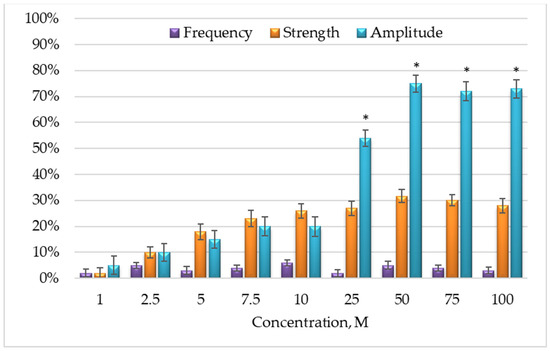
Figure 2.
Concentration–effect relationship showing the influence of DIQ on the strength, frequency, and amplitude of spontaneous CA on SMP of the rat stomach. The contraction evoked by 1 μM ACh in the same tissues was found to be 100% (n = 16), *—statistically significant differences (p < 0.05).
All effects examined were reversible, and the amplitude of these contractions did not change after several applications of DIQ. Each individual application in the tissue bath was separated by changing the Krebs solution with a fresh solution. Its effect generally became significant at a concentration of 25 to 100 μM, when the amplitude was above 50%. The maximal effect of DIQ was observed at a concentration of 50 μM, which was approximately 31.6% of the force of contractions evoked by 1 μM ACh on the same tissues.
The presented results correspond to our previous experiments [15,16,17,18,19], which prove that 1-substituted tetrahydroisoquinolines possess contractile activity and can influence the spontaneous CA of SMP isolated from guinea pigs or rats. The observed CA was not spasmolytic, as usual for this class of compounds. The CA is due to the presence of conjugated double bonds [15,20,21,22].
Influence of Specific and Nonspecific Cholinergic Receptor Agonists and Antagonists on DIQ Contractile Effect
Following the treatment of specific receptors in SM cells with biologically active substances, the characteristics and strength of spontaneous contractions were monitored.
In general, suppressed mACh receptors (mAChR) have an inhibitory effect on Ach release from the presynaptic terminal due to a balance between inhibiting M2/M4 and stimulating their release through M1 receptors. These receptors alternatively influence potassium influx through the presynaptic membrane and intracellular calcium concentration [23]. To establish the role of DIQ in SM contraction processes, we investigated how mAChR agonists and mAChR antagonists affect them. In gastric SM strips experiments, a significant decrease in the size of the contractions was observed in the presence of the mAChR agonist arecoline [24] and the non-selective mAChR antagonists atropine and ipratropium (Table 1). We assumed that the effects of DIQ on the contractile processes are probably caused by a specific triggering action they exert on mAChRs in gastric SM tissue.

Table 1.
Changes in the tonus of SMPs under the influence of DIQ. The comparison is between DIQ tonic effects in Krebs solution (benchmark) and the presence of selective mAChR and nAChR agonists or antagonists; n—number of SMPs; *—statistically significant differences (p < 0.05).
The changes in the strength of DIQ-induced contraction that were observed in the activity of nonspecific muscarinic agonists and antagonists are logical. In both cases, DIQ’s ability to activate all mAChRs was reduced because the isoquinoline molecule interacts with either already activated or already blocked receptors.
In various gastrointestinal SMs, ACh and its derivatives produce contractions by activating mAChRs. From the family of muscarinic receptors, M1 mAChR, M2 mAChR, and M3 mAChR are expressed predominantly in SM cells [25]. Their activation initiates the processes of Ca2+ release from the depots and the activation of L-type Ca2+ channels where the cytosolic Ca2+ concentration increases, and the contraction process is started. Thus, we have tracked the action of the effectiveness of the selective antagonists for M1 mAChR (dicyclomine and pirenzepine), M2 mAChR (gallamine and alcuronium), and M3 mAChR (4-DAMP and tiotropium) to the DIQ-provoked contractile reaction [26,27,28,29,30]. We found that only with the preliminary M3 mAChR blocking their specific antagonists could a statistically significant decrease in SM response be observed when simultaneously administering DIQ (Table 1, Figure 3). This experimental result indicates that DIQ activity is likely to be related to its influence on intracellular pathways.
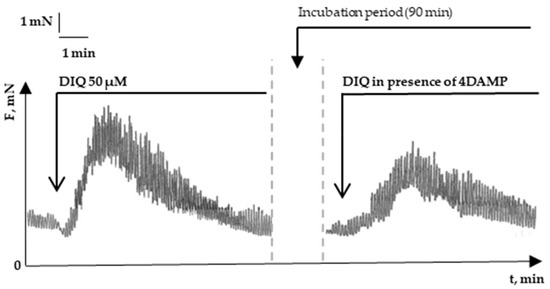
Figure 3.
Representative tracings showing the influence of 4-DAMP on the contractile effect of DIQ.
The specific responses observed can be attributed to the parallel pathways induced by DIQ, affecting the contractility of SMPs in the rat stomach. The influence of nicotinic ACh receptors (nAChR) on the DIQ contraction was not considered, since the preliminary blocking of nAChR with hexamethonium and decamethonium (10 μM for the two groups of experiments) did not have a significant effect on the strength of the studied contraction (Table 1).
Ca2+ ions are necessary for contractions and they enter SM cells mainly through voltage-gated Ca2+ channels. Thus, to clarify the pathway of DIQ activity more specifically, we decided to apply the nonselective L-type Ca2+ channel blocker nifedipine, as well as a selective agent, verapamil, in the tissue baths. The nonselective calcium-blocking agent inhibits SM contractions in various organs, including gastric muscle in vitro [31]. We observed that nifedipine at a concentration of 0.5 μM significantly reduced the strength of the contractile reaction caused by 50 μM DIQ from 2.99 ± 0.17 mN to 0.36 ± 0.06 mN (Table 1). The effect of verapamil at a 0.3 μM concentration is similar—a significant reduction in the contractile response strength from 3.01 ± 0.09 mN to 0.73 ± 0.09 mN. These experimental results indicate that the DIQ contractile effect on SMPs is probably associated with an increase in the cytosolic Ca2+ level by activating voltage-gated L-type Ca2+ channels [32]. These results undoubtedly confirm our initial hypothesis regarding the pathway used by the DIQ’s CA.
CA is influenced by different substances that are secreted by neurons in the enteric or autonomic nervous system. Some substances, such as 5-HT, ACh, epinephrine, dopamine, etc., predominantly affect gastrointestinal SMs [33]. ACh is a major neurotransmitter in enteric neurons, which activates the multiple receptors expressed in SM and thus influences SM contraction through the secondary intermediaries IP3 and DAG. On the other hand, activated cytosolic IP3 and DAG initiate some intracellular pathways with the participation of phospholipase C, calmodulin, and myosin light chain protein kinase, thus mediating SM contraction. The neurotransmitter 5-HT influences SM contractility by increasing [Ca2+]i via the 5-HT2 receptor subtype, inducing an influx of extracellular Ca2+ through L-type voltage-dependent Ca2+ channels [34]. Recent studies showed that enteric 5-HT is a polyfunctional signaling molecule that facilitates communication between the enteric nervous system and effector systems (muscles, secretory endothelium, endocrine cells, and the vascular network of the gastrointestinal tract) [35]. The damage and imbalance in serotonergic signaling that influences gastrointestinal motility, secretion, and visceral sensitivity are influenced by defects and deficits in 5-HT production and specific 5-HT receptors [36]. It is known that medicines which target 5-HT signaling molecules are effective in alleviating the symptoms of functional gastrointestinal disturbances. We found that when ACh or 5-HT was exogenously applied in a concentration of 1 μM on SM, a contractile effect with values of 4.91 ± 0.25 mN and 3.88 ± 0.16 mN, respectively, was registered. ACh at the abovementioned concentration applied after DIQ 50 μM does not change the strength of its response, but the strength of the DIQ-induced effect significantly decreases in the presence of 1 μM ACh to 1.15 ± 0.09 mN (Table 2).

Table 2.
Mutual influence on contractile activity caused by DIQ on rat circular gastric SMPs and the application of exogenous neurotransmitters ACh and 5-HT: *—p < 0.05. n—the number of SMPs used in the experiments.
In contrast to ACh, after premedication with the other major neuromediator, 5-HT, we found a reduction in the tonic component by 61.5% in the DIQ-induced contractile reaction. The contractile reaction of the neurotransmitter 5-HT in the presence of 50 μM DIQ was also reduced by 60.1% (Figure 4). This mutual influence of the action of 5-HT and DIQ on isolated SMPs experimentally confirms the biological effect predicted in silico which, in this case, is reflected by the change in the physiological functions of the model SM system.
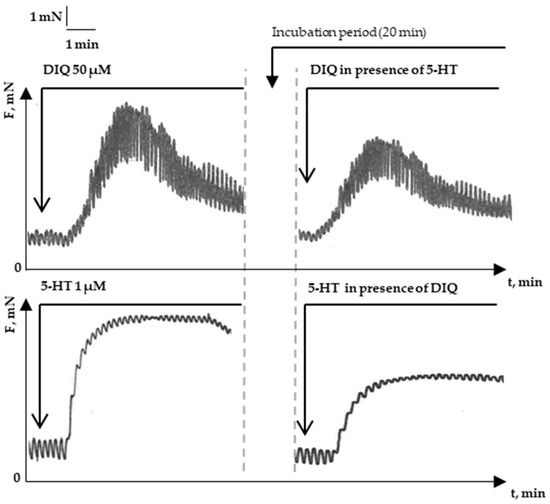
Figure 4.
Representative features of SM strip contraction induced by 1 μM 5-HT and 50 μM DIQ under single or combined administration.
The selected experimental SM model is as simple as possible due to the combined use of isolated tissues and organs from one animal for the SM test and the histological test, respectively.
2.2. Histological Determination of the Effect of DIQ on SM
Immunohistochemistry (IHC) localization and registration of the biological effect of DIQ is an optimal instrument for physiological and pharmacological studies aimed at clarifying the mechanisms of action on receptor systems or receptor interactions.
2.2.1. Morphological Analysis
The histological analysis of SMPs we performed, in which the substance was incubated for 20 min with 5-HT (1 μM), DIQ (50 μM), and a combination of the two substances DIQ+5-HT in their respective concentrations, followed by staining with hematoxylin–eosin (Figure 5A–C), did not register any changes in the two SM layers and the MP between them.
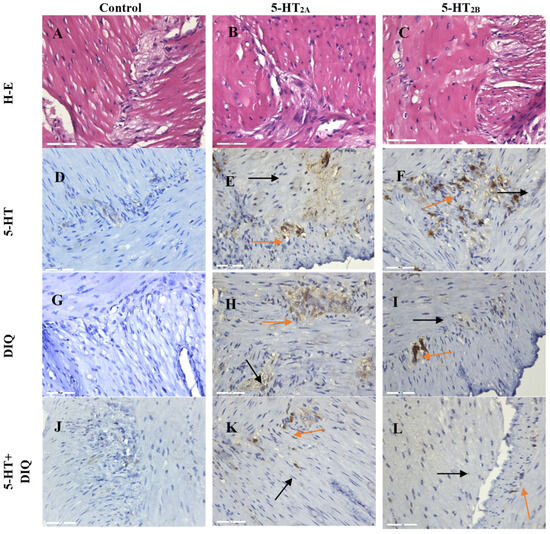
Figure 5.
Expression of 5-HT2A and 5-HT2B receptors in gastric preparations (×400 magnification). (A) GM preparation incubated with 5-HT, H-E staining; (B) incubated with DIQ, H-E staining; (C) incubated with 5-HT+DIQ, H-E staining; (D) incubated with 5-HT, control; (E) incubated with 5-HT, increased intensity, and density in 5-HT2A expression in MP (orange arrows) and SM (black arrows); (F) incubated with 5-HT, in presence of 5-HT2B expression in MP (orange arrows) and mild expression in SM (black arrows); (G) incubated with DIQ, control; (H) incubated with DIQ, a reduced 5-HT2A expression is registered; (I) incubated with DIQ, individual cells for 5-HT2B are noticed in the MP(orange arrows) and SM (black arrows); (J) incubated with 5-HT+DIQ, control; (K) incubated with 5-HT+DIQ, mild 5-HT2A expression is registered in MP (orange arrows) and SM (black arrows); (L) incubated with 5-HT+DIQ, reduced intensity in 5-HT2B expression in MP (orange arrows) and SM (black arrows). The incubation period is 20 min.
2.2.2. 5-HT2A and 5-HT2B Immune Reaction Determination
IHC analysis indicates an increased expression of 5-HT2A receptors (Figure 5E) and 5-HT2B receptors (Figure 5F) in SM cells and in the MP (Figure 5D) after 5-HT treatment compared to controls. The incubation of tissue preparations in DIQ showed a significant decrease in the expression of 5-HT2A (Figure 5H) and 5-HT2B (Figure 5I) by 43% and 27% respectively, compared to those incubated with 5-HT only (Figure 5E,F). Moreover, we established a reduction in the expression of 5-HT2A (Figure 5K) and 5-HT2B (Figure 5L) by 16% and 12%, respectively, after 5-HT+DIQ combined incubation compared to 5-HT incubation only (Figure 5E,F). A significant reduction in neural activity was registered in the SMPs treated with DIQ alone or in combination with 5-HT.
The statistical data processing (Figure 6a,b) confirmed the immunohistological observations. The IHC results showed a statistically significant difference between the measurements after the treatment of preparations with 5-HT and DIQ separately, compared to the simultaneous treatment of 5-HT and DIQ. The mean distribution analysis of the results for 5-HT2A and 5-HT2B in MP and SM cells showed a significantly lowered percentage of 5-HT2A- (Figure 6a) and 5-HT2B- (Figure 6b) positive cells per slice when treated with the combination of 5-HT and DIQ compared to those treated with 5-HT and DIQ separately (p < 0.05).

Figure 6.
Activity of 5-HT receptors 5-HT2A and 5-HT2B following individual and combined application of 5-HT and DIQ, on rat SM from the stomach and MP. t-test was used, where * p < 0.05.
Based on the experimental results observed, we can conclude that the specific biological response of SM cells and neurons in MP in the presence of DIQ is expressed as a significant reduction in the expression of the 5-HT2A and 5-HT2B receptors according to both histological tests conducted. Physiological functions such as contraction and secretion are usually regulated by multiple receptor-mediated mechanisms. Some sequential steps (e.g., receptor binding, multiple intracellular secondary mediators) may intervene between the initial molecular drug-receptor interaction and the final tissue or organ response. Thus, several different pathways can often be used to obtain the same expected response. Our data suggest that the biological effects of DIQ on isolated smooth muscle may be partially caused by a decrease in the density of both membrane serotonin receptors and the associated control of Ca2+ influx across the cell surface.
3. Materials and Methods
3.1. Solutions and Chemicals
The composition of the Krebs solution was as follows (in mM): sodium chloride 120, potassium chloride 5.9, calcium chloride 2.5, magnesium chloride MgCl2 1.2, Sodium Bicarbonate 15.4, monosodium phosphate 1.2, glucose 11.5. The perfusion fluid was aerated with a mixture of O2 and CO2 (in a ratio of 95%: 5%), and pH was maintained at 7.40.
The commercially available medicines used were acetylcholine (ACh), 5-HT, nifedipine, verapamil, dicyclomine, alcuronium, arecoline, atropine, ipratropium, pirenzepine, gallamine, tiotropium, 4-diphenylacetoxy-N-methylpiperidine methiodide (4-DAMP methiodide), hexamethonium, and decamethonium. All chemicals and reagents were used without further purification.
Monoclonal anti-SR-2A (A-4) and anti-SR-2B (C-6) antibodies (sc-166775, sc-376878, Santa Cruz, Dallas, Texas, USA, 1:150) were used. IHC staining was performed by using the Autostainer Link 48 (DakoLink IHC Solution, Glostrup, Denmark) with ascending grades of ethanol (70%, 80%, 96%, 100%).
Concentrated stock solutions of these substances were prepared in a solvent recommended by the manufacturer and aliquots of these stock solutions were added to the tissue bath to obtain the desired concentration. The volume of aliquots was less than 1% of the Krebs solution volume of the tissue bath and was measured continuously with the pH meter HI-5521 (Hanna Instruments Inc., Woonsocket, RI, USA). Deionized water with a conductivity of 18.2 mΩ/cm2 was used in all experiments and for the preparation of all necessary solutions.
3.2. Smooth Muscle Preparations
Male Wistar rats with a body weight of 255–285 g (age 10–12 weeks) were used. The animals were observed under standard conditions: room temperature 22 ± 2 °C, free access to water and food and a 12 h dark/light cycle. Two or three circular SM strips were dissected from one rat stomach in situ, separating the muscle tissue and keeping the mucosa intact. The sizes of strips 10–12 mm in length and 1.1–1.3 mm in width, were used to isometrically record the CA. The preparations indicated by n were carried out under conditions of continuous irrigation of tissues with a pre-aerated preparation solution containing sodium chloride/potassium chloride/calcium chloride in a ratio of 27.2/1.1/1 with a temperature of 4 °C.
All experimental procedures were approved by the current European regulations (86/609/EEC) regarding the protection of animals used for experimental purposes, and performed in strict accordance with the current Institutional Animal Care guidelines in Bulgaria and comply with the EU Directive 2010/63/EU.
3.3. Registration of the Mechanical Activity of Rat Circular Gastric SM
The CA of SMPs was registered isometrically. The initial mechanical tension of the SMPs was achieved by stretching the tension system with a force of 10 mN. After a 60 min adaptation period, during which the Krebs solution was changed 4 times, and the stabilized spontaneous activity was accepted as the initial tonus. The spontaneous alterations in the mechanical activity and tonus were recorded at this this level utilizing a system of tensodetector (Swema, Stockholm, Sweden) coupled with an amplifier (Microtechna, Prague, Czech Republic) and recorded with polygraph (Linseis, Selb, Germany) (Figure 7). The viability of SMPs was tested by stimulation with a 1 μM ACh neurotransmitter.
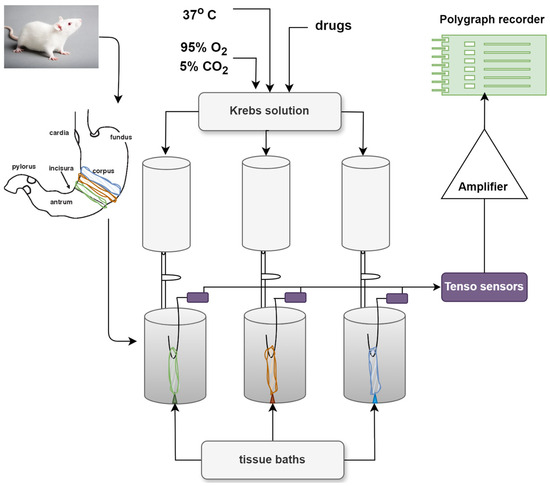
Figure 7.
Principle scheme of the experimental setup for recording the mechanical activity of rat circular gastric SM strips in tissue baths.
3.4. Histological Examination
Stomach tissues were washed with physiological saline solution. They were then placed for 20 min in the isolated tissue bath at 5% CO2, 95% O2, and 37 °C following the conditions of CA recording experiments. After the incubation time had finished, each SM strip was fixed with 10% neutral formalin.
3.4.1. Hematoxylin-Eosin Staining
After conventional embedding in paraffin wax, 4 serial sections were cut and stained with hematoxylin-eosin for 5 min. Then, slides were dehydrated in a graded ethanol series, cleared with fresh xylene, and mounted onto a slide.
3.4.2. Immunohistochemistry
IHC staining was performed on formalin-fixed and paraffin-embedded 5 μm sections followed by citrate pH 6.0 antigen retrieval, endogenous biotin, and peroxidase blocking. The SM strips were stained for IHC with mouse monoclonal antibodies anti-SR-2A (A-4) and anti-SR-2B (C-6). The images were visualized and captured with a digital camera mounted on a Nikon Eclipse 80i microscope using NIS-Elements Advanced Research Software version 4.13 (Nikon Instruments; Tokyo, Japan). Photomicrographs were observed at a magnification of ×400.
3.4.3. Quantitative Analysis of IHC Reactions
The values were obtained after analysis by groups (n = 6) per SM strip. Cells expressing SR-2A and SR-2B in the SM cells and MP of the stomach were analyzed. A grid (19 × 25 fields) was used, through which the number of cells expressing SR-2A/SR-2B marker was determined, according to the formula x = (n/475) × 100, where n is the number of squares in which there are positive cells for SR-2A/SR-2B, and 475 is the total number of squares.
3.5. Statistics
The experimental results are presented as the mean ± standard error of the mean (SEM). The number of tissue preparations used in each experiment is denoted by n. Statistical differences were tested using the Student’s t-test. The probability of less than 5% (p < 0.05) was considered significant. Data analysis was performed using the statistical software SPSS, version 16.0 (SPSS Inc. Chicago, IL, USA).
4. Conclusions
The present work showed the ex vivo contractile activity of DIQ. The main reason for such behavior is the presence of conjugated double bonds and their ability to activate mAChRs and 5-HT receptors. The experimental results indicated that the specific biological activity of DIQ is significantly reduced in the presence of initially administered receptor agonists, antagonists, and neurotransmitters.
In the SMPs incubated in DIQ, a significant decrease in the expression of 5-HT2A and 5-HT2B was observed during the IHC analysis. A tendency for the expression of both receptors to decrease when the combination of DIQ and 5-HT is applied is reported. The specific biological response of SM cells and neurons in MP in the presence of DIQ is expressed as a significant reduction in the expression of both serotonin receptors—5-HT2A and 5-HT2B. Based on the experimental results, we can conclude that DIQ is a polyfunctional signaling molecule that affects both SM and MP.
Author Contributions
Conceptualization, I.S. and S.N.; methodology, S.N., M.M., M.P. and V.G.; investigation, V.G., M.P., M.M., S.N. and V.S., writing—original draft preparation, I.S. and V.G.; writing—review and editing, S.N. and M.M.; visualization, V.G., V.S. and M.P.; supervision, I.S. and S.N. All authors have read and agreed to the published version of the manuscript.
Funding
This research received no external funding.
Institutional Review Board Statement
The procedures used in this study agreed with the European Communities Council Directive 2010/63/EU for animal experiments. The experimental procedures were conducted following national rules on animal experiments and were approved by the Bulgarian Food Safety Agency (No. 229/No. 145/09.04.2019).
Informed Consent Statement
Not applicable.
Data Availability Statement
The original contributions presented in the study are included in the article, further inquiries can be directed to the corresponding authors.
Acknowledgments
This study is part of Scientific Project No. KP-06-H73/11 of the National Fund for Scientific Research in Bulgaria, National Program for Basic Research Projects—2023.
Conflicts of Interest
The authors declare no conflicts of interest.
References
- Shang, X.-F.; Yang, C.-J.; Morris-Natschke, S.L.; Li, J.-C.; Yin, X.-D.; Liu, Y.-Q.; Guo, X.; Peng, J.-W.; Goto, M.; Zhang, J.-Y.; et al. Biologically active isoquinoline alkaloids covering 2014–2018. Med. Res. Rev. 2020, 40, 2212–2289. [Google Scholar] [CrossRef] [PubMed]
- Khan, A.Y.; Kumar, G.S. Natural isoquinoline alkaloids: Binding aspects to functional proteins, serum albumins, hemoglobin, and lysozyme. Biophys. Rev. 2015, 7, 407–420. [Google Scholar] [CrossRef] [PubMed]
- Qian, J.-Q. Cardiovascular pharmacological effects of bisbenzylisoquinoline alkaloid derivatives. Acta Pharmacol. Sin. 2002, 23, 1086–1092. [Google Scholar] [PubMed]
- Qing, Z.-X.; Yang, P.; Tang, Q.; Cheng, P.; Liu, X.-B.; Zheng, Y.J.; Liu, Y.-S.; Zeng, J.-G. Isoquinoline alkaloids and their antiviral, antibacterial, and antifungal activities and structure-activity relationship. Curr. Org. Chem. 2017, 21, 1920–1934. [Google Scholar] [CrossRef]
- Sharma, D.; Sharma, N.; Manchanda, N.; Prasad, S.K.; Sharma, P.C.; Thakur, V.K.; Rahman, M.M.; Dhobi, M. Bioactivity and in silico studies of isoquinoline and related alkaloids as promising antiviral agents: An insight. Biomolecules 2023, 13, 17. [Google Scholar] [CrossRef] [PubMed]
- Ahmed, W.; Huang, Z.-H.; Cui, Z.-N.; Tang, R.-Y. Design and synthesis of unique thiazoloisoquinolinium thiolates and derivatives. Chin. Chem. Lett. 2021, 32, 3211–3214. [Google Scholar] [CrossRef]
- Bentley, K.W. β-Phenylethylamines and the isoquinoline alkaloids. Nat. Prod. Rep. 2006, 23, 444–463. [Google Scholar] [CrossRef]
- Luo, C.; Ampomah-Wireko, M.; Wang, H.; Wu, C.; Wang, Q.; Zhang, H.; Cao, Y. Isoquinolines: Important cores in many marketed and clinical drugs. Anticancer Agents Med. Chem. 2021, 21, 811–824. [Google Scholar] [CrossRef] [PubMed]
- Milusheva, M.; Gledacheva, V.; Stefanova, I.; Nikolova, S. 1-(2-Chlorophenyl)-6,7-dimethoxy-3-methyl-3,4-dihydroisoquinoline. Molbank 2023, 2023, M1608 . [Google Scholar] [CrossRef]
- Hendrickx, S.; Caljon, G.; Maes, L. Need for sustainable approaches in antileishmanial drug discovery. Parasitol. Res. 2019, 118, 2743–2752. [Google Scholar] [CrossRef]
- Alqudah, M.; Razzaq, R.A.; Alfaqih, M.A.; Al-Shboul, O.; Al-Dwairi, A.; Taha, S. Mechanism of oxytocin-induced contraction in rat gastric circular smooth muscle. Int. J. Mol. Sci. 2023, 24, 441. [Google Scholar] [CrossRef]
- Jespersen, B.; Tykocki, N.; Watts, S.; Cobbett, P. Measurement of smooth muscle function in the isolated tissue bath-applications to pharmacology research. J. Vis. Exp. 2015, 95, 52324. [Google Scholar] [CrossRef]
- Röhm, K.; Diener, M.; Huber, K.; Seifert, J. Characterization of cecal smooth muscle contraction in laying hens. Vet. Sci. 2021, 8, 91. [Google Scholar] [CrossRef]
- Matthew, A.; Shmygol, A.; Wray, S. Ca2+ entry, efflux and release in smooth muscle. Biol. Res. 2004, 37, 617–624. [Google Scholar] [CrossRef] [PubMed]
- Ivanov, I.; Nikolova, S.; Aladjov, D.; Stefanova, I.; Zagorchev, P. Synthesis and contractile activity of substituted 1,2,3,4-tetrahydroisoquinolines. Molecules 2011, 16, 7019–7042. [Google Scholar] [CrossRef]
- Gledacheva, V.N.; Stefanova, I.D.; Slavchev, V.I.; Ardasheva, R.G.; Kristev, A.D.; Nikolova, S.A.; Saracheva, K.E.; Dimitrova, D.S. Impact of a newly synthesized molecule (2-chloro-N-(1-(3,4-dimethoxyphenyl) propan-2-yl)-2-phenylacetamide) on the bioelectrogenesis and the contractile activity of isolated smooth muscles. Folia Med. 2020, 62, 532–538. [Google Scholar] [CrossRef]
- Gledacheva, V.; Pencheva, M.; Nikolova, S.; Stefanova, I. Ability of 2-chloro-N-(1-(3,4-dimethoxyphenyl)propan-2-yl)-2-phenylacetamide to stimulate endogenous nitric oxide synthesis. Appl. Sci. 2022, 12, 4473. [Google Scholar] [CrossRef]
- Milusheva, M.; Gledacheva, V.; Batmazyan, M.; Nikolova, S.; Stefanova, I.; Dimitrova, D.; Saracheva, K.; Tomov, D.; Chaova-Gizdakova, V. Ex vivo and in vivo study of some isoquinoline precursors. Sci. Pharm. 2022, 90, 37. [Google Scholar] [CrossRef]
- Milusheva, M.; Gledacheva, V.; Stefanova, I.; Pencheva, M.; Mihaylova, R.; Tumbarski, Y.; Nedialkov, P.; Cherneva, E.; Todorova, M.; Nikolova, S. In silico, in vitro, and ex vivo biological activity of some novel mebeverine precursors. Biomedicines 2023, 11, 605. [Google Scholar] [CrossRef]
- Drazen, J.; Lewis, R.; Austen, F.; Toda, M.; Brion, F.; Marfat, A.; Corey, E. Contractile activities of structural analogs of leukotrienes C and D: Necessity of a hydrophobic region. Proc. Nati. Acad. Sci. USA 1981, 78, 3195–3198. [Google Scholar] [CrossRef]
- Zhang, D.; Fan, G. Application of Conjugated Materials in Muscle Movement Recovery Process. Front. Chem. 2023, 11, 1246926. [Google Scholar] [CrossRef] [PubMed]
- Gonzalez, C.; Silva-Ramirez, A.S.; Navarro-Tovar, G.; Barrios-Capuchino, J.J.; Rocha-Uribe, A. Effect of the Double Bond Conjugation on the Vascular Physiology and Nitric Oxide Production of Isomers of Eicosapentaenoic and Docosahexaenoic Acids Prepared from Shark Oil. PLoS ONE 2020, 15, e0229435. [Google Scholar] [CrossRef] [PubMed]
- Tanahashi, Y.; Komori, S.; Matsuyama, H.; Kitazawa, T.; Unno, T. Functions of muscarinic receptor subtypes in gastrointestinal smooth muscle: A review of studies with receptor-knockout mice. Int. J. Mol. Sci. 2021, 22, 926. [Google Scholar] [CrossRef] [PubMed]
- Li, C.B.; Yang, X.; Tang, W.B.; Liu, C.Y.; Xie, D.P. Arecoline excites the contraction of distal colonic smooth muscle strips in rats via the M3 receptor-extracellular Ca2+ influx–Ca2+ store release pathway. Can. J. Physiol. Pharmacol. 2010, 88, 439–447. [Google Scholar] [CrossRef] [PubMed]
- Tanahashi, Y.; Kitazawa, T.; Unno, T. Muscarinic Regulation of Gastrointestinal Motility. Neuromethods 2024, 211, 307–340. [Google Scholar] [CrossRef]
- Giachetti, A.; Giraldo, E.; Ladinsky, H.; Montagna, E. Binding and functional profiles of the selective M1 muscarinic receptor antagonists trihexyphenidyl and dicyclomine. Br. J. Pharmacol. 1986, 89, 83–90. [Google Scholar] [CrossRef] [PubMed]
- Yu, M.; Robinson, N.E.; Wang, Z.; Derksen, F.J. Muscarinic receptor subtypes in equine tracheal smooth muscle. Vet. Res. Commun. 1992, 16, 301–310. [Google Scholar] [CrossRef] [PubMed]
- May, L.T.; Lin, Y.; Sexton, P.M.; Christopoulos, A. Regulation of M2 muscarinic acetylcholine receptor expression and signaling by prolonged exposure to allosteric modulators. J. Pharmacol. Exp. Ther. 2005, 312, 382–390. [Google Scholar] [CrossRef]
- Kruse, A.C.; Hu, J.; Pan, A.C.; Arlow, D.H.; Rosenbaum, D.M.; Rosemond, E.; Green, H.F.; Liu, T.; Chae, P.S.; Dror, R.O.; et al. Structure and dynamics of the M3 muscarinic acetylcholine receptor. Nature 2012, 482, 552–556. [Google Scholar] [CrossRef]
- Ehlert, F.J.; Sawyer, G.W.; Esqueda, E.E. Contractile role of M2 and M3 muscarinic receptors in gastrointestinal smooth muscle. Life Sci. 1999, 64, 387–394. [Google Scholar] [CrossRef]
- Santander, R.; Mena, I.; Gramisu, M.; Valenzuela, J.E. Effect of nifedipine on gastric emptying and gastrointestinal motility in man. Dig. Dis. Sci. 1988, 33, 535–539. [Google Scholar] [CrossRef] [PubMed]
- Nayler, W.G.; Poole-Wilson, P. Calcium antagonists: Definition and mode of action. Basic. Res. Cardiol. 1980, 76, 1–15. [Google Scholar] [CrossRef] [PubMed]
- Yang, X.; Lou, J.; Shan, W.; Ding, J.; Jin, Z.; Hu, Y.; Du, Q.; Xie, Q.L.R.; Xu, J. Pathophysiologic role of neurotransmitters in digestive diseases. Front. Physiol. 2021, 12, 567650. [Google Scholar] [CrossRef]
- Hirafuji, M.; Nezu, A.; Kanai, Y.; Ebihara, T.; Kawahara, F.; Tanimura, A.; Minami, M. Effect of 5-hydroxytryptamine on intracellular calcium dynamics in cultured rat vascular smooth muscle cells. Res. Commun. Mol. Pathol. Pharmacol. 1998, 99, 305–319. [Google Scholar] [CrossRef]
- Guzel, T.; Mirowska-Guzel, D. The role of serotonin neurotransmission in gastrointestinal tract and pharmacotherapy. Molecules 2022, 27, 1680. [Google Scholar] [CrossRef]
- Talley, N.J. Serotoninergic neuroenteric modulators. Lancet 2001, 358, 2061–2068. [Google Scholar] [CrossRef] [PubMed]
Disclaimer/Publisher’s Note: The statements, opinions and data contained in all publications are solely those of the individual author(s) and contributor(s) and not of MDPI and/or the editor(s). MDPI and/or the editor(s) disclaim responsibility for any injury to people or property resulting from any ideas, methods, instructions or products referred to in the content. |
© 2024 by the authors. Licensee MDPI, Basel, Switzerland. This article is an open access article distributed under the terms and conditions of the Creative Commons Attribution (CC BY) license (https://creativecommons.org/licenses/by/4.0/).